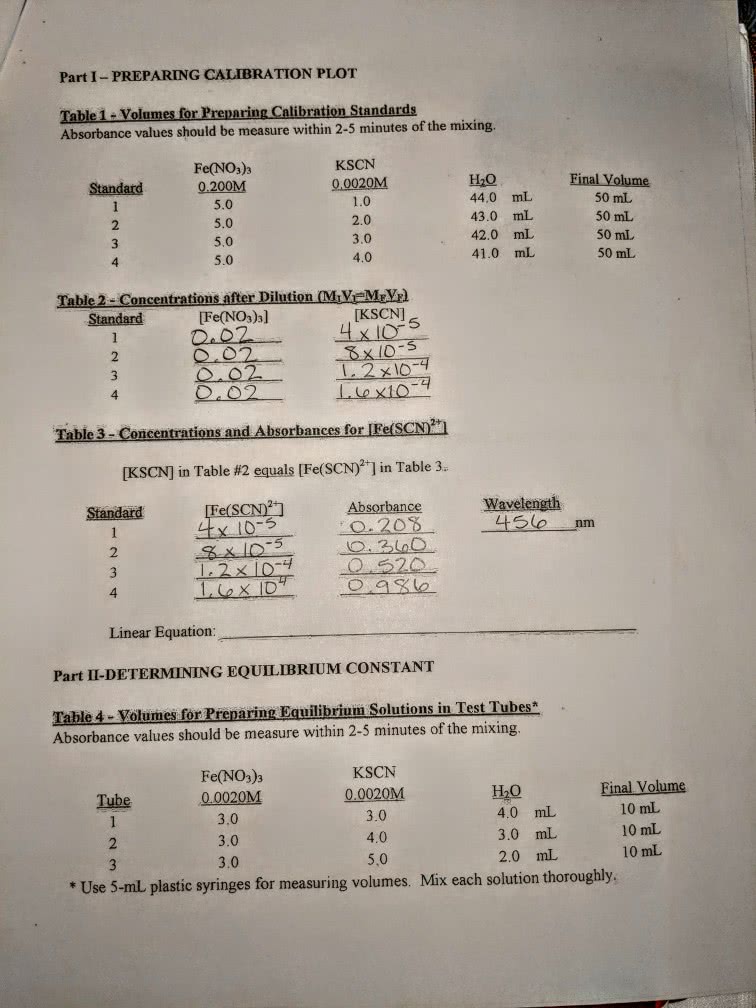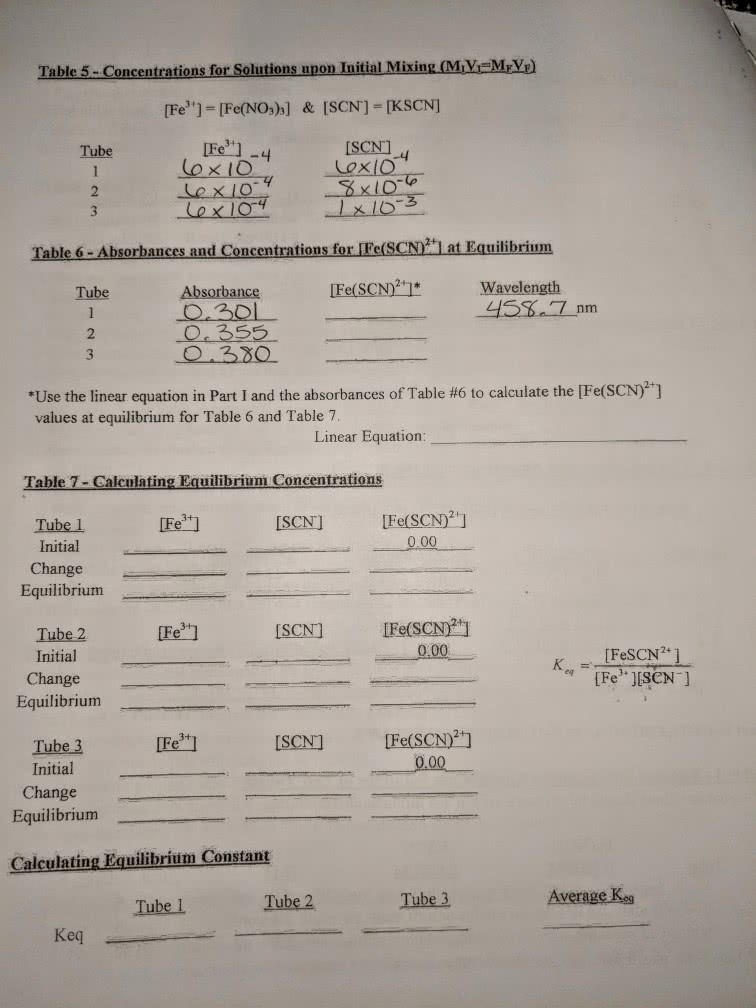CHEMISTRY REPORT DUE TONIGHT HELP!!! About Equilibrium Constants, and I would appreciate any feedback that can help me answer my last couple of questions!!
Part 2: Determining the equilibrium constant
Table .2 shows the amounts of 2.00 ´ 10â3 M Fe(NO3)3 (in 1 M HNO3) solution, 2.00 ´ 10-3 M KSCN solution, and DI water that you should add to each tube. Add these chemicals to your three test tubes. Note that your test tubes are labeled by number. Be sure to add the solutions to the correct tube. Pipet the approximate amount of each solution into each tube. On your data sheet, record the exact amount of each solution that you add. You will need to use these actual amounts in your calculations.
Table 2 Composition of solutions for determining the equilibrium constant.
Test Tube
Vol of 2.00 ´ 10-3 M Fe(NO3)3 in 1 M HNO3 (mL)
Vol of 2.00 ´ 10-3 M KSCN (mL)
Vol of DI water
(mL)
1
5.0
1.0
4.0
2
5.0
2.0
3.0
3
5.0
3.0
2.0
4
5.0
4.0
1.0
5
5.0
5.0
0
Data and Results
3. You have been told that the reaction you are observing is:
Fe3+ (aq) + SCN-â (aq) â FeSCN2+ (aq)
Another possibility is that the reaction is:
Fe3+ (aq) + 2 SCN-â (aq) â Fe(SCN)2+ (aq)
Write the equilibrium equation for this new reaction.
Using your data from the mixtures in test tubes 1, 3, and 5 of Part 2, recalculate three new equilibrium constants for this new possible reaction. Hint: Notice that the change in concentration of SCN- in your equilibrium table will change because of the new stoichiometry. Also, the exponent on [SCN-] in the equilibrium constant expression will change for the same reason.
What are the three new equilibrium constants?
Why do the results of your calculations show that the reaction you are observing is more likely to be the first one (one mole of SCN- with one mole of Fe3+)?
4. In Part 1 of this experiment, you made the assumption that the FeSCN2+concentrations in your standard solutions were equal to the initial concentrations of SCN- ions. Now that you know the value of the equilibrium constant, calculate the actual equilibrium concentrations of Fe3+, SCN-, and FeSCN2+ in mixture in test tube 2. How good was the assumption? Did this satisfy the 5% rule (the loss of reactant is less than 5% of its initial concentration)?
CHEMISTRY REPORT DUE TONIGHT HELP!!! About Equilibrium Constants, and I would appreciate any feedback that can help me answer my last couple of questions!!
Part 2: Determining the equilibrium constant
Table .2 shows the amounts of 2.00 ´ 10â3 M Fe(NO3)3 (in 1 M HNO3) solution, 2.00 ´ 10-3 M KSCN solution, and DI water that you should add to each tube. Add these chemicals to your three test tubes. Note that your test tubes are labeled by number. Be sure to add the solutions to the correct tube. Pipet the approximate amount of each solution into each tube. On your data sheet, record the exact amount of each solution that you add. You will need to use these actual amounts in your calculations.
Table 2 Composition of solutions for determining the equilibrium constant.
| Test Tube | Vol of 2.00 ´ 10-3 M Fe(NO3)3 in 1 M HNO3 (mL) | Vol of 2.00 ´ 10-3 M KSCN (mL) | Vol of DI water |
| 1 | 5.0 | 1.0 | 4.0 |
| 2 | 5.0 | 2.0 | 3.0 |
| 3 | 5.0 | 3.0 | 2.0 |
| 4 | 5.0 | 4.0 | 1.0 |
| 5 | 5.0 | 5.0 | 0 |
Data and Results
3. You have been told that the reaction you are observing is:
Fe3+ (aq) + SCN-â (aq) â FeSCN2+ (aq)
Another possibility is that the reaction is:
Fe3+ (aq) + 2 SCN-â (aq) â Fe(SCN)2+ (aq)
Write the equilibrium equation for this new reaction.
Using your data from the mixtures in test tubes 1, 3, and 5 of Part 2, recalculate three new equilibrium constants for this new possible reaction. Hint: Notice that the change in concentration of SCN- in your equilibrium table will change because of the new stoichiometry. Also, the exponent on [SCN-] in the equilibrium constant expression will change for the same reason.
What are the three new equilibrium constants?
Why do the results of your calculations show that the reaction you are observing is more likely to be the first one (one mole of SCN- with one mole of Fe3+)?
4. In Part 1 of this experiment, you made the assumption that the FeSCN2+concentrations in your standard solutions were equal to the initial concentrations of SCN- ions. Now that you know the value of the equilibrium constant, calculate the actual equilibrium concentrations of Fe3+, SCN-, and FeSCN2+ in mixture in test tube 2. How good was the assumption? Did this satisfy the 5% rule (the loss of reactant is less than 5% of its initial concentration)?



